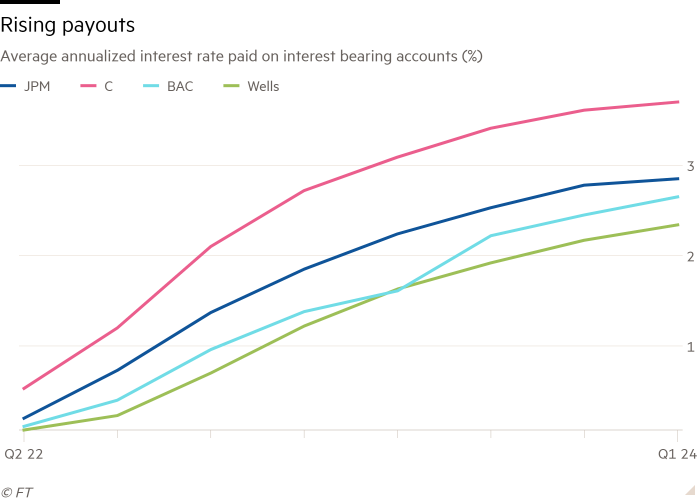
Stay informed with free updates
Simply sign up to the US banks myFT Digest — delivered directly to your inbox.
Deposit costs at the largest US banks rose more than interest revenue last quarter for the first time since the Federal Reserve began raising rates two years ago, as savers demanded lenders share the benefits.
Wells Fargo paid nearly $594mn more in fees to depositors in the first quarter of this year than it did in the previous three months. That was far more than the $1mn the bank took in additional interest from its loans and investments in the same period.
JPMorgan Chase and Citi also paid out more to depositors than they took in additional interest last quarter — about $350mm each. In the previous quarter, the two banks took in $2.3bn more in additional interest above what they paid depositors.

At Bank of America, rising deposit costs equalled two-thirds of new interest received in the quarter.
“Regardless of what happens to rates, deposit costs are going to continue to rise,” said Greg Hertrich, who is the head of US depository strategies at Nomura.
“Traditionally, the way it has worked is that your deposit base usually came from your same metropolitan area. But in today’s environment, the vast majority of deposit rates are advertised to a much wider audience than they used to be.”
After two years of climbing, the extra amount banks are having to pay out to keep depositors has started to slow. Deposit costs were up an average of 5 per cent in the first three months of the year, compared with the previous quarter, at BofA, Citi, JPMorgan and Wells Fargo, to $1.5bn. That is down from a 13 per cent jump in the fourth quarter, and 38 per cent a year ago.
The problem is that, with rates seemingly at their peak, the interest payments the banks are collecting from their loans and investments has nearly stalled. In the first three months of this year, interest revenue at the same four banks rose on average less than one half of one per cent, up about $500mn, from the quarter before.
“Lending demand has not rebounded at the level they had hoped,” said Hertrich.
The banks still retain the vast majority of the interest they collect, paying out just 26 per cent of those revenues, on average, to depositors in their most recent quarter. On average, the nation’s biggest banks pay an average interest rate of 2.9 per cent to depositors, up from 1.8 per cent a year ago, but still well below the Fed’s short-term official interest rate of 5.5 per cent.
JPMorgan executives said that the bank’s drop in interest income in its most recent quarter, the first time that has happened in nearly three years, was largely because of rising pressure to pay depositors more.
“As we’ve been saying for a while, migration from checking and savings to CDs is sort of the dominant trend,” JPMorgan’s chief financial officer Jeremy Barnum told analysts on the bank’s first-quarter earnings call. “We continue to capture that money-in-motion at a very high rate.”

